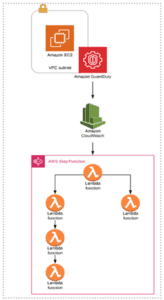AWS stands for Amazon Web Service and has been the talk of the town for the last few years in the tech industry. It is not unknown that AWS offers many services and is the leading cloud platform that provides a one-stop solution for all cloud services. From startups to big enterprises, AWS services have been known to increase performance, productivity, and overall efficiency. In this article, you will learn about the top 10 AWS services in 2022 and their features along with benefits.
What is AWS?
AWS stands for Amazon Web Services. It offers around 200+ resources pertaining to infrastructure, cloud services and also includes machine learning. AWS is right now the largest cloud service provider in the tech industry.
Why use AWS services?
AWS services are provided by Amazon and are designed around varied areas of development and utilities.
- Amazon hosts many data centres all around the world and has a vast network. This ensures reduced latency which is one of the main reasons to use AWS services.
- It has free tiers and access to the AWS console where users and admins can control their configurations.
- It can be replicated and hence the duplication of services regionally is possible through AWS. This can result in less downtime and fast recovery.
- Software applications can be deployed within minutes by using the AWS services.
- It reduces the need to write additional code by developers for deployment.
- Using AWS services increases scalability, flexibility, and efficient IT infrastructure.
- These AWS services are cost-saving and faster than most stand-alone cloud services.
While there are tons of options, figuring out which one fits right for your needs is challenging. It can be overwhelming to learn about all the available solutions. Hence, I have rounded up the top 10 AWS services that you should know about.

EC2
Amazon EC2 stands for Elastic Compute Cloud. It is known to be one of the fastest growing cloud computing services that is offered by AWS. The main goal of EC2 is to provide virtual servers to manage any size of workload. Organisations no longer have to worry about physical servers. EC2 also ensures support for security, ports, processors and networking facilities. Amazon EC2 is opted since it is a highly reliable IT infrastructure solution.
S3
Amazon S3 stands for Simple Storage Service. It provides industry leading storage service. S3 is very easy to use and provides data availability, scalability, performance and security. I personally used Amazon S3 and cannot recommend it enough. Data is stored in buckets that function as folders and can be used as online backup. You can access any amount of data from anywhere anytime.
SNS
SNS stands for Simple Notification Service. It provides messaging service between applications. This AWS SNS service can be used for messaging between event-driven serverless applications, microservices, distributed systems and sends messages via email, text, and other types. It notifies the user based on a single API request and the messages can be filtered.
Lambda
AWS Lambda is one of the most recommended services by developers as it helps run code automatically without the need to worry about servers and clusters. It accepts code execution requests and the price is charged only for the computed time. Code can be uploaded directly without provisioning or managing infrastructure in any organisation which is why it is highly popular for achieving scalability and reducing costs.
RDS
Amazon’s Relational Database Service (RDS) is a managed database solution for multiple database engines like MySQL, PostgreSQL, SQL Server, and many more. RDS makes the infrastructure-less complicated by providing dedicated instances in minutes.
IAM
IAM stands for Identity Access Management. AWS IAM ensures secure access and resource management. Creating users, managing access to groups, and allowing as well rejecting permissions are possible through AWS identity and access management.
Cloudwatch
Amazon Cloudwatch was designed for DevOps engineers, Site Reliability Engineers (SRE), and IT managers. Cloudwatch allows users to monitor various applications through a console. Developers can take actions for abnormal behaviour of systems, scale resources, and generate reports on the overall health of the system with the help of logs and events.
VPC
Amazon Virtual Private Cloud (VPC) is used to control a networking environment. VPC is a separate resource that is responsible for connectivity and security in the cloud. Building and managing VPC networks for inbound and outbound connections are made easier with this service. VPC also communicates with Amazon S3 and Cloudwatch to gain traffic patterns and access to network connectivity by providing logs. It has also been popular for detecting abnormal patterns in the network and preventing data leakage which is crucial for cybersecurity.
Amazon RedShift
RedShift is Amazon’s quick and easy data warehousing service. It is used to gain access to data, perform analysis on large volumes of data and run complex queries. Amazon RedShift’s major benefit is that this service increases query speed and provides a more secure and faster way for data analysis.
Amazon CloudFront
This AWS service is recommended quite a lot in the dev world. It is primarily used to deliver data with high speed. This results in lower latency and increase in performance. CloudFront is known to deliver content with network mapping which is automated at a global scale. The most interesting part is that cloudfront can transfer data within milliseconds with its built-in computing capabilities, encryption, and data compression.
Conclusion
I hope that this post was useful for you to understand which AWS services are in demand right now. Use this to gain knowledge or begin your journey with AWS services for your own needs or your organisation. AWS services solve many problems worldwide quickly and efficiently thereby increasing productivity as well as security for business applications and networks. Consider all the factors before choosing the right service for your requirements.








